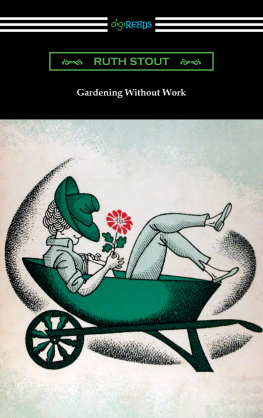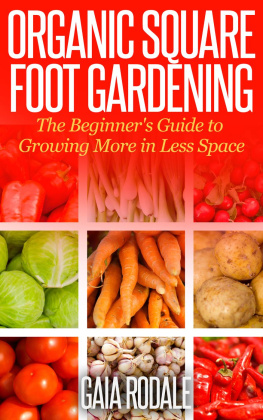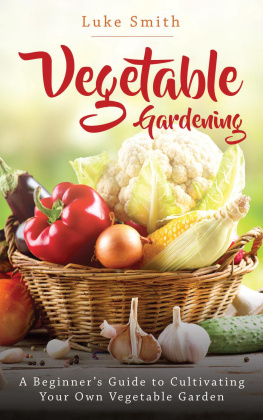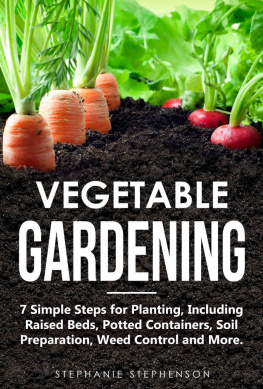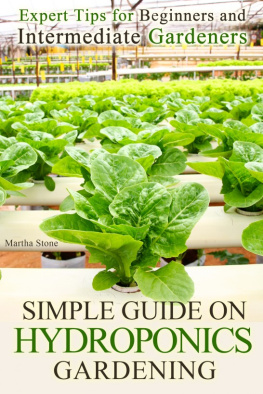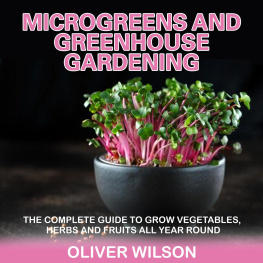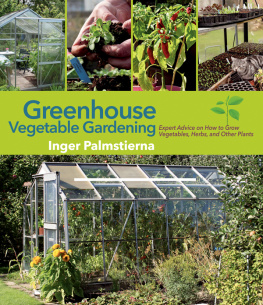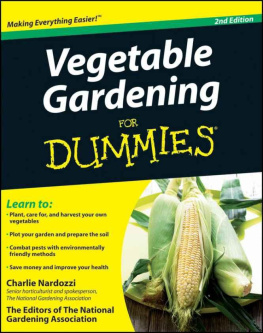How to Have a Green Thumb
Without an Aching Back
A NEW METHOD OF MULCH GARDENING
By Ruth Stout
Introduction by Steven W. Siler
Sowing in the sunshine, sowing in the shadows.
Fearing neither clouds nor winter's chilling breeze;
By and by the harvest, and the labor ended.
We shall come rejoicing, bringing in the sheaves.
For Fred Rossiter
Other Ruth Stout books can be found here:
Gardening Without Work
The No-Work Garden
Table of Contents
Introduction by
I grew up on a family road outside of Atlanta, Georgia. When I say a family road, I mean our family name was on the road sign, and the 27 houses that were on it were kin to me in some way or another. Understand, that as this was an old, small, Southern community, most of the town was also related to me, in one way or another. With family that close, it also meant that you could not get away with hardly anything without a cousin or grandmother being witness to your most recent indiscretion. Who would have thought sweet Aunt Mary Alice was a snitch? Anyway
Another commonality of the road is that it was built around gardening. Granddaddy had acquired a 100-year lease on the land between the road and the parallel railroad tracks, in addition to the one-acre garden behind the house. As the youngest grandson on the road, my inestimable worth to gardening consisted of being ballast weight to drive the harrow discs deeper into Georgia red clay. I wasnt content to remain in this subaltern position, and I was soon tasked with walking behind it, busting bigger clods of dirt into smaller clods. With my bare feet.
Apparently, my clod-busting skills caught the attention of my grandfather, and with a keen eye for talent, I was promoted to Seed Planter. This all-important task meant that I tended the planter, a two-handled behemoth from Purina Mills circa 1928. Originally intended to be pulled behind a Jenny mule, shouting Gee and Haw to maintain appropriate row spacing, it was now pulled by a slightly newer McCormick Farmall Cub, circa 1948. The tractor required a hardy soul to wind the hand crank in the front cowling, and on ignition, quickly remove the crank and run back to wrestle the planter into an upright position. Unfortunately, over the noise of the engine, my grandfather heard my vocal pleadings about as well as that old mule; consequently rows that I first planted resembled attempts at cursive handwriting.
What does this have to do with Ruth Stout?, you might ask. Well, what I didnt realize was that my grandfather was a follower of hers, at least in spirit. First off, he was an early adoptee of mulch gardening. Every fall, we laid out an old faded blue comforter and piled it full of post oak leaves. Twenty to thirty trips later to the gardens, and this leaf mulch was the secret sauce in transforming our gardens into Gardens of (vegetable) Eden. Years later, those gardens, simply left to go fallow, would yield tomato plants literally 7 feet tall.
In addition, Granddaddy certainly adopted a No-Work gardening attitude of the first order, letting Nature do his work. Granted, this was accomplished by my being frequently volunteered to do the heavy lifting, but it came with certain perqs. If it was just the two of us, he would use his Barlow to cut a plug of Browns Mule tobacco for my personal enjoyment. I might have been queasy-headed and on the verge of fertilizing the Silver Queen kernels, but I felt like the man he hoped one day I would be. Mercifully, Grandmama would idle down with a couple bottles of Coca Cola, the green bottles sweating like I was.
Finally, my grandfather possessed and passed on, a satisfaction with and love of gardening. Many a sultry summer evening would draw to a close under a chorus of crickets and reel of lightning bugs. Family members who had stopped by to pull corn (you pick peas, you pull corn and you chop cotton...dont ask me why) would gather on the wrought iron lawn chairs, trading stories and opinions and generally admiring the bounty of the land...and generously ignoring the slightly crooked rows. And looking back, one realized you were literally in the Garden of Eden.
Chapter 1. A Lilac Bush and an Apple Tree
WHEN MY HUSBAND AND I are alone in the evenings I lie on the couch over by the fireplace and read. Fred is stretched out in his green leather chair on the opposite side of the big living room. If I mutter to myself he doesnt even look up from his book. He knows what is wrong: Im exasperated at some statement about gardening Im reading which contradicts my own experience.
Through the years my mutterings kept changing as I kept gathering first-hand knowledge. They began with: Oh, I did that all wrong. Then: How interesting!How surprising! I wonder?That sounds cockeyed. Oh, for the love of Mike!Ridiculous!Is he crazy? Why doesnt he wake up? Naturally, I read many things I agreed with, but when I agreed I didnt growl.
I have finally come to the conclusion that a lot of people who write on this inexhaustible subject are armchair gardeners, and after twenty-five years of experience in growing things my opinion is that armchair gardeners can say some very peculiar things.
My ambition is to write this book without a single statement which can be muttered at. I will try to accomplish this by relating my own experiences, letting the reader do the conclusion- drawing.
This does not mean, however, that my mind isnt crowded with opinions and convictions. It is. For instance, eleven years ago I put into practice a revolutionary method of gardening, and if I were put in charge of the world I would make it compulsory for every gardener to give it a three-year trial. After three years I dont believe anyone would go back to the old, cumbersome procedure. If someone did, if someone deliberately chose to work ten times as long and as hard as he needed, chose to spend more money and have more headaches than necessary with less satisfactory results, I wouldnt interfere. I doubt if there would be enough of them in the whole world to fill a medium sized mental institution.
This method is described in detail in Chapters Six and Seven. In Chapter Eight you will find an easy and effective way to grow strawberries. I would not try to force this idea on anyone for, in my experience, it sells itself automatically to anyone who sees it or has it explained to him. So if I were running the world I wouldnt make that a law, but simply broadcast it.
The first five chapters are a story of the struggles I went through and the things I learned during the early years of gardening. I am hoping that someone may benefit from this account of my mistakes and triumphs, my heartaches and enchantments.
If heartache sounds exaggerated then surely you have never gone to your garden one rare morning in June to find that the frost, without any perceptible motive, any hope of personal gain, has quietly killed your strawberry blossoms, tomatoes, lima and green beans, com, squash, cucumbers. A brilliant sun is now smiling at this disaster with an insensitive cheerfulness as out of place as a funny story would be if someone you loved had just died.
And if enchantment sounds a little far fetched you have not yet opened your eyes and heart to the unassuming miracle of the performance of a tiny seed as insignificant-looking as a fleck of dust. If you put a tomato seed, for instance, into the earth, and barely cover it, it will send a tender green shoot up through the soil. You can help it to do this with less strain if you cover it for a few days with a board, strip of cardboard, gunny- sack, or anything to keep it moist and prevent the light from reaching it.
But you must watch it. As soon as you see the shoot breaking through the ground the cover must come off . Then this little, live thing keeps getting bigger and greener and more and more surprising. It covers itself with green leaves and later wi th yellow blossoms. Did you ever stop to wonder how it decided always to have them yellow?
Next page

